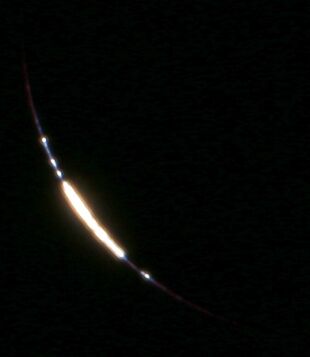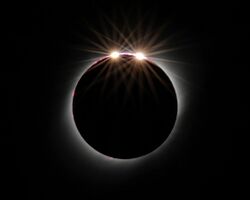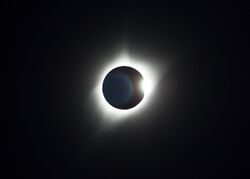Earth:Baily's beads
The Baily's beads effect, and diamond ring, and, more rarely, double diamond ring, effects[1] are features of total and annular solar eclipses. Although caused by the same phenomenon, they are distinct events during these types of solar eclipses. As the Moon covers the Sun during a solar eclipse, the rugged topography of the lunar limb allows beads of sunlight to shine through in some places while not in others. The effect is named after Francis Baily, who explained the phenomenon in 1836.[2][3] The diamond ring effects are seen when only one or two beads are left, appearing as shining "diamonds" set in a bright ring around the lunar silhouette.[4]
Lunar topography has considerable relief because of the presence of mountains, craters, valleys, and other topographical features. The irregularities of the lunar limb profile (the "edge" of the Moon, as seen from a distance) are known accurately from observations of grazing occultations of stars. Astronomers thus have a fairly good idea which mountains and valleys will cause the beads to appear in advance of the eclipse. While Baily's beads are seen briefly for a few seconds at the center of the eclipse path, their duration is maximized near the edges of the path of the umbra, lasting 1–2 minutes.
It is not safe to view Baily's beads or the diamond ring effect without proper eye protection because in both cases the photosphere is still visible.[5]
Observers in the path of totality of a solar eclipse see first a gradual covering of the Sun by the lunar silhouette for just a small duration of time from around one minute to four minutes, followed by the diamond ring effect (visible without filters) as the last bit of photosphere disappears. As the burst of light from the ring fades, Baily's beads appear as the last bits of the bright photosphere shine through valleys aligned at the edge of the Moon.[6] As the Baily's beads disappear behind the advancing lunar edge (the beads also reappear at the end of totality), a thin reddish edge called the chromosphere (the Greek chrōma meaning "color") appears. Though the reddish hydrogen radiation is most visible to the unaided eye, the chromosphere also emits thousands of additional spectral lines.[7]
Observational history
Although Baily is often said to have discovered the cause of the feature which bears his name, Sir Edmond Halley made the first recorded observations of Baily's beads during the solar eclipse of 3 May 1715.[8][Note 1] Halley described and correctly ascertained the cause of the effect[8] in his "Observations of the late Total Eclipse of the Sun [...]" in the Philosophical Transactions of the Royal Society:
About two Minutes before the Total Immersion, the remaining part of the Sun was reduced to a very fine Horn, whose Extremeties seemed to lose their Acuteness, and to become round like Stars ... which Appearance could proceed from no other Cause but the Inequalities of the Moon's Surface, there being some elevated parts thereof near the Moon's Southern Pole, by whose Interposition part of that exceedingly fine Filament of Light was intercepted.[8]
The term "Baily's beads" then came into use after Baily described the phenomenon to the Royal Astronomical Society in December 1836. Having observed the solar eclipse of 15 May 1836 from Jedburgh in the Scottish Borders, he reported that:
...when the cusps of the sun were about 40 degrees asunder, a row of lucid points, like a string of beads, irregular in size, and distance from each other, suddenly formed around that part of the circumference of the moon that was about to enter on the sun's disc.[9]
In media
In 1735, painter and architect Cosmas Damian Asam completed a painting that is probably the earliest known work that realistically depicts a total solar eclipse and diamond ring.[10]
The Diamond Ring effect is seen during the credit opening sequence of Star Trek: Voyager (1995-2001), albeit from a fictitious extrasolar body, as seen from space.[citation needed]
The Baily's beads phenomenon is seen during the credit opening sequence of the NBC TV show Heroes (2006-2010).[citation needed]
Gallery
Diamond ring effect visible during the total solar eclipse of August 21, 2017, in Ravenna, Nebraska. (The diffraction spikes emanating tangentially from the diamond are an artifact of the camera optics, not a natural phenomenon.)
The diamond ring effect as totality ends during the total solar eclipse of August 21, 2017, in central Wyoming. The rainbow coloration is a lens flare and not a natural phenomenon.
References
Notes
- ↑ Great Britain did not adopt the Gregorian calendar until 1752, so at the time of the eclipse, the date was recorded as 22 April 1715.
Citations
- ↑ 1.0 1.1 Staff (27 December 2023). "Searching for the Double Diamond Ring". PhotoEphemeris.com. Archived from the original on 30 December 2023. https://archive.today/20231230181624/https://photoephemeris.com/articles/searching-for-the-double-diamond-ring. Retrieved 30 December 2023.
- ↑ Baily (1836). "I. On a remarkable phenomenon that occurs in total and annular eclipses of the sun". Monthly Notices of the Royal Astronomical Society 4 (2): 15–19. doi:10.1093/mnras/4.2.15.
- ↑ Littmann, Mark; Willcox, Ken; Espenak, Fred (1999). Totality – Eclipses of the Sun. Oxford University Press. pp. 65–66. ISBN 978-0-19-513179-6.
- ↑ O. Staiger. "The Experience of Totality". http://www.mreclipse.com/Totality2/TotalityCh01.html.
- ↑ "Solar Eclipse Observing--The Diamond Ring and Baily's Beads". https://alpo-astronomy.org/eclipse/observeeclipses/chapter9.htm.
- ↑ Pasachoff, J. M. & Covington, M. The Cambridge Eclipse Photography Guide (Cambridge Univ. Press, 1993)[page needed]
- ↑ Pasachoff, Jay M. (2009). "Solar eclipses as an astrophysical laboratory". Nature 459 (7248): 789–795. doi:10.1038/nature07987. PMID 19516332. Bibcode: 2009Natur.459..789P.
- ↑ 8.0 8.1 8.2 Pasachoff, Jay M. (1999). "Halley and his maps of the Total Eclipses of 1715 and 1724". Journal of Astronomical History and Heritage 2 (1): 39. Bibcode: 1999JAHH....2...39P.
- ↑ Baily (1836). "I. On a remarkable phenomenon that occurs in total and annular eclipses of the sun". Monthly Notices of the Royal Astronomical Society 4 (2): 15–19. doi:10.1093/mnras/4.2.15.
- ↑ Nemiroff, R.; Bonnell, J., eds (2008-01-28). "A Solar Eclipse Painting from the 1700s". Astronomy Picture of the Day. NASA. https://apod.nasa.gov/apod/ap080128.html.
External links
- "What to See During an Eclipse Continued". Exploratorium. 2009-06-22. https://www.exploratorium.edu/eclipse/what-to-see-during-eclipse.
- Joseph B. Gurman (2005-04-14). "Total Solar Eclipse of 1998 February 26". Goddard Space Flight Center. http://umbra.nascom.nasa.gov/eclipse/980226/rp.html.
 |





